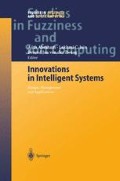Summary
This chapter presents a full explanation facility for any standard MLP network with binary input neurons that performs a classification task. The interpretation of any input case is represented by a non-linear ranked data relationship of key inputs. The knowledge that the MLP has learned is represented by ranked class profiles or as a set of rules. The explanation facility discovers the MLP knowledge bounds, enabling novelty detection to be implemented and the predictability of the MLP to be investigated. Results using the facility are presented for a 48-dimensional real world MLP that classifies low-back-pain patients.
Access this chapter
Tax calculation will be finalised at checkout
Purchases are for personal use only
Preview
Unable to display preview. Download preview PDF.
References
Andrews R, Diederich J, Tickle AB (1995) Survey and Critique of Techniques for Extracting Rules from Trained Artificial Neural Networks. Knowledge-Based Systems 8 (6): 373–389
Bigos S, Bowyer O, Braen G (1994) Acute Low Back Problems in Adults. Clinical Practice Guideline No. 14. AHCPR Publication No. 95–0642. U.S. DHHS
Bologna, G (1996), Rule Extraction from the IMLP Neural Network: A Comparative Study. Proc. NIPS’96 Workshop of Rule Extraction from Trained Artificial Neural Networks. Queensland Univ. Technol
Bounds DG, Lloyd PJ, Mathew B (1990) A Comparison of Neural Network and Other Pattern Recognition Approaches to the Diagnosis of Low Back Disorders. Neural Networks Vol. 3. 583–591
Cloete I, Zurada JM (1999) Knowledge-Based Neurocomputing, MIT Press, Cambridge, MA.
Craven MW, Shavlik JW (1993) Learning symbolic rules using artificial neural networks. In: Proceedings Tenth International Conference on Machine Learning. Amherst MA, USA. Morgan Kauffman, pp 73–80.
Craven MW, Shavlik JW (1994) Using Sampling and Queries to Extract Rules from Trained Neural Networks. In: Machine Learning. Proceedings Eleventh International Conference on Machine Learning, Amherst, MA,USA. Morgan Kaufmann, pp 73–80
Denker J, Schwarz D, Witmer B, Solla S, Howard R, Jackel, L, Hopfield J (1987) Large Automatic Learning, Rule Extraction, and Generalisation. Complex Systems, 1, 877–922
Fu L (1994) Neural Networks in Computer Intelligence, McGraw-Hill, London
Gallant SI (1993) Neural Network Learning and Expert Systems. MIT Press, Cambridge, MA.
Jackson D, Llewelyn-Phillips H, Klaber-Moffett J (1996) Categorization of Back Pain Patients Using an Evidence Based Approach. Musculoskeletal Management 2: 39–46
Krishnan R (1996) A Systematic Method for Decompositional Rule Extraction from Neural Networks. Proceedings NIPS’96 Workshop of Rule Extraction from Trained Artificial Neural Networks. Queensland University of Technology, pp 38–45
Looney CG (1997) Pattern Recognition Using Neural Networks. New York, Oxford University Press.
Maire F (1997) A Partial Order for the M-of-N Rule Extraction Algorithm. IEEE Trans. Neural Networks 8: 1542–1544
Saito K, Nakano R (1996) Law Discovery Using Neural Networks. Proceedings NIPS’96 Workshop of Rule Extraction from Trained Artificial Neural Networks. Queensland University of Technology, pp 62–69
Setiono R (1997) Extracting Rules from Neural Networks by Pruning and Hidden Unit Splitting. Neural Computing 1 9: 205–225
Taha IA, Ghosh J (1999) Symbolic Interpretation of Artificial Neural Networks. IEEE Trans. Neural Networks 11 (3): 448–463
Thrun, SB (1995) Extracting rules from artificial neural networks with distributed representations. In: Tesauro G, Touretzky D, Leen T (eds) Advances in Neural Information Processing Systems. MIT Press, 7: 505–512
Tickle AB, Orlowski M, Diederich J (1996) DEDEC: A Methodology for Extracting Rules from Trained Artificial Neural Networks. In: Proceedings NIPS’96 Workshop of Rule Extraction from Trained Artificial Neural Networks. Queensland University of Technology, pp 90–102
Tickle AB, Andrews R, Golea M, Diederich J (1998) The Truth Will Come to Light: Directions and Challenges in Extracting the Knowledge Embedded Within Trained Artificial Neural Networks. IEEE Trans. Neural Networks, 9 (6): 1057–1067
Towell, GG, Shavlik JW (1993) Extracting Refined Rules from Knowledge Based Neural Networks. Machine Learning 13: 71–101
Vaughn ML (1996) Interpretation and Knowledge Discovery from the Multi Layer Perceptron Network: Opening the Black Box. Neural Computing www Applications Journal. 4 (2): 72–82
Vaughn ML, (1999) Derivation of the Weight Constraints for Direct Knowledge Discovery from the Multilayer Perceptron Network. Neural Networks 12: 1259–1271
Vaughn ML, Cavill SJ, Taylor SJ, Foy MA, Fogg AJB (2000) Direct Explanations and Knowledge Extraction from a Multilayer Perceptron Network that Performs Low Back Pain Classification. In: Wermter S, Sun R (eds) Hybrid Neural Systems. Springer, pp 270–285
Vaughn ML, Cavill SJ, Taylor SJ, Foy MA, Fogg AJB (2001) Direct Explanations for the Development and Use of a Multi-Layer Perceptron Network that Classifies Low Back Pain Patients. International Journal Neural Systems 11(4):335–347
Waddell G (1987) A New Clinical Model for the Treatment of Low-Back Pain. Spine 12 (7): 632–644
Waddell G, Bircher M, Finlayson D, Main C (1984) Symptoms and Signs: Physical Disease or Illness Behaviour. BMJ 289: 739–741
Wermter S, Sun R (2000) Hybrid Neural Systems, Springer
Editor information
Editors and Affiliations
Rights and permissions
Copyright information
© 2004 Springer-Verlag Berlin Heidelberg
About this chapter
Cite this chapter
Vaughn, M.L., Cavill, S.J., Taylor, S.J., Foy, M.A., Fogg, A.J.B. (2004). A Full Explanation Facility for an MLP Network That Classifies Low-Back-Pain Patients and for Predicting MLP Reliability. In: Abraham, A., Jain, L., van der Zwaag, B.J. (eds) Innovations in Intelligent Systems. Studies in Fuzziness and Soft Computing, vol 140. Springer, Berlin, Heidelberg. https://doi.org/10.1007/978-3-540-39615-4_16
Download citation
DOI: https://doi.org/10.1007/978-3-540-39615-4_16
Publisher Name: Springer, Berlin, Heidelberg
Print ISBN: 978-3-642-05784-7
Online ISBN: 978-3-540-39615-4
eBook Packages: Springer Book Archive

